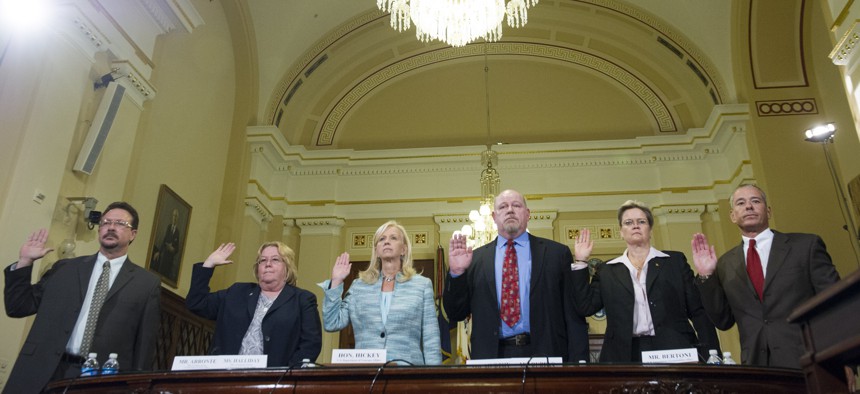
Witnesses are sworn-in before testifying to the House Committee on Veterans' Affairs hearing to review the Veterans Benefits Administrations progress in ending its disability compensation claims backlog by 2015, on Capitol Hill, Monday, July 14, 2014. AP Photo/Cliff Owen
VA's New Paperless Claim System Has Nearly Doubled in Costs
The agency’s deputy IG told lawmakers the billion-dollar (and counting) system may not be worth the money.
The Department of Veterans Affairs may finally have good news to share, but lawmakers are balking at the price tag.
Total costs for a digital system used to process veterans’ disability claims that officials say has been key to slashing a massive VA backlog are nearly double the initial estimates.
And VA, which has continued to make upgrades to the system under an “agile” software development methodology, still can’t say how much the system will end up costing, according to auditors.
VA has spent more than $1 billion developing and maintaining the Veterans Benefits Management System, or VBMS, since 2009. The agency has requested an additional $290 million this year for continued tweaks to the system, which was initially projected to cost $579 million.
At a House VA committee hearing Tuesday, the agency’s deputy inspector general, Brent Arronte, warned lawmakers the agency cannot ensure it’s getting a return on its billion-dollar investment and that costs “will continue to spiral upward.”
First, the good news: The Web-based application replaced a largely paper-based process used to track veterans’ disability benefits. The longstanding backlog of disability claims at the agency is down from a high of 600,000 in 2013 to about 80,000 currently, the lowest in VA’s history.
And in contrast to other big-budget IT projects that fail upon launch or get canceled after wasting millions before ever getting off the ground, VA’s initial system launched ahead of schedule in June 2013 -- albeit with a some early glitches.
Initially, the system was designed to act simply as an electronic claims repository.
"We didn't stop there,” said Beth McCoy, VA’s deputy undersecretary for field operations. “We went on to add in automation, because that made sense and that was the right thing to do for veterans and for our employees."
Following the agile method, VA has been rolling out new features and functionality every three months, McCoy told Congress, delivering 17 major software releases and 56 more minor updates over the past four years.
But watchdogs -- including the IG and the Government Accountability Office -- say VA lacks clear goals for further development of the system
VA has yet to produce a plan that identifies when VBMS will be completed, testified Valerie Melvin, director of information management at GAO.
"Thus, the department lacks an effective means to hold management accountable for meeting a timeframe and demonstrating progress on completing the system,” Melvin testified.
Republican lawmakers, who have fiercely criticized VA management in recent years, are impatient with VA's approach to improving the system.
“You're going to go through the appropriations process this year and say, 'We want more money, but we don't know when this will end and what the final cost will be for a very specific project?’" said Rep. Tim Huelskamp, R-Kan.
That’s the nature of agile development, VA officials said.
“VBMS is different because we use what we refer to as agile,” said Dawn Bontempo, director of the Veterans Benefits Management System program management office. “And that means that we can release software every three months and bring high-value functionality to the field as quickly as possible to serve our veterans.
Traditionally, the federal government has used a “waterfall” approach when developing and implementing large IT projects. Agency planners exhaustively gather system requirements upfront. Those are then turned over to the IT development shop, which builds the system. And years later, the agency may have a functioning system.
“We did not go down that path,” Bontempo said. “We used something called agile, which allowed us to take and build requirements as we were going along.”
However, GAO, which has identified incremental development as a best practice that could help agencies stay on top of failure-prone IT projects, also agrees VA needs reliable cost estimates for completing the system or risks flying blind.
“Without such an estimate, management and stakeholders have a limited view of the system's future resource needs and the program risks not having sufficient funding to complete the system," Melvin testified.



